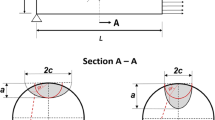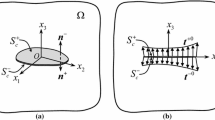Abstract
This paper deals with such a kind of surface crack problem with an approximately same depth, which is called a liked-plane crack problem. Based on the previous investigations on internal rectangular crack and surface rectangular crack in infinite solid in tension and a hybrid displacement discontinuity method (a boundary element method) proposed recently by Yan, a numerical approach for the liked-plane crack problem in hand is presented. Numerical examples are given to illustrate the numerical approach is simple, yet accurate for calculating the SIFs of a liked-plane crack. Specifically, a pair of cracks emanating from a surface elliptical hole in infinite body in tension are investigated in detail.
Similar content being viewed by others
References
Murakami Y (1987) Stress intensity factors handbook. Pergamon, Elmsford
Bowie OL (1956) Analysis of an infinite plate containing radial cracks originating at the boundary of an internal circular hole. J Math Phys 35:60–71
Newman JC Jr (1971) An improved method of collocation for the stress analysis of cracked plates with various shaped boundaries. NASA TN, D-6376, pp 1–45
Nisitani H, Isida M (1982) Simple procedure for calculating K I of a notch with a crack of arbitrary size and its application to non-propagating fatigue crack. In: Proc ioint JSME-SESA conf on experimental mechanics, Part I, pp 150–155
Murakami Y (1978) A method of stress intensity factor calculation for the crack emanating from an arbitrarily shaped hole or the crack in the vicinity of an arbitrarily shape hole. Trans Jpn Soc Mech Eng 44(378):423–432
Murakami Y, Isida M (1985) Analysis of an arbitrarily shaped surface crack and stress field at crack front near surface. Trans Jpn Soc Mech Eng 51(464):1050–1056
Murakami Y, Nemat-Nasser S (1983) Growth and stability of interacting surface flaws of arbitrary shape. Eng Fract Mech 17(3):193–210
Yoshida T (1984) Effect of boundaries on stress intensity factors. PhD thesis, Kyushu University, Fukuoka, Japan
Kassir KK (1981) Stress intensity factors for a three-dimensional rectangular crack. ASME J Appl Mech 48(2):309–312
Yan X (2005) An efficient and accurate numerical method of SIFs calculation of a branched crack. ASME J Appl Mech 72(3):330–340
Zhao W, Newman JC Jr, Sutton MA et al. (1998) Stress intensity factors for surface cracks at a hole by a three-dimensional weight function method with stresses from the finite element method. Fatigue Fract Eng Mater Struct 21(2):229–239
Newman JC Jr, Reuter WG, Aveline CR Jr (1999) Stress and fracture analyses of semi-elliptical surface cracks. ASTM STP 1360:403–423
Newman JC Jr, Bigelow CA, Shivakumar KN (1993) Three-dimensional elastic-plastic finite element analyses of constraint variations in cracked bodies. Eng Fract Mech 46(1):1–13
Shivakumar KN, Newman JC Jr (1991) Stress intensity factors for large aspect ratio surface and corner cracks at a semi-circular notch in a tension specimen. Eng Fract Mech 38(6):467–473
Tan PW, Newman JC Jr, Bigelow CA (1996) Three-dimensional finite-element analyses of corner cracks at stress concentrations. Eng Fract Mech 55(3):505–512
Raju IS, Newman JC Jr (1979) Stress-intensity factors for two symmetric corner cracks. ASTM STP 677:411–430
Newman JC Jr, Raju IS (1981) Empirical stress-intensity factor equation for surface crack. Eng Fract Mech 15(1–2):185–192
Murakami Y, Endo M (1985) Effects of hardness and crack geometry on ΔKth of small cracks emanating from small defects. Presented at int symposium on the behavior of short fatigue cracks, University of Sheffield, pp 25–28
Isida M, Noguchi H, Yoshida T (1984) Tension and bending of finite thickness plates with a semi-elliptical surface cracks. Int J Fract 26:157–188
Isida M, Yoshida T, Noguchi H (1983) Tension of a plate with a pair of semi-elliptical surface cracks. Trans Jpn Soc Mech Eng 49(448):1572–1580
Charambides PG, McMeeking RM (1987) Finite element method simulation of a crack propagation in a brittle microcracked solid. Mech Mater 6:71–87
Huang X, Karihaloo BL (1993) Interaction of penny shaped cracks with a half plane crack. Int J Solids Struct 25:591–607
Yan X (2006) An effective numerical approach for multiple void-crack interaction. ASME J Appl Mech 73(4):525–535
Yan X (2003) Analysis of the interaction of arbitrary multiple cracks in an infinite plate interference effect of arbitrary multiple parabolic cracks in plane elasticity by using a new boundary element method. Comput Methods Appl Mech Eng 192(47–48):5099–5121
Yan X (2004) Interaction of arbitrary multiple cracks in an infinite plate. J Strain Anal Eng Des 39(3):237–244
Yan X (2005) Microdefect interacting with a finite main crack. J Strain Anal Eng Des 40(5):421–430
Yan X (2006) A brief evaluation of approximation methods for microcrack shielding problems. ASME J Appl Mech 73(4):694–696
Yan X (2005) Stress intensity factors for asymmetric branched cracks in plane extension by using crack tip displacement discontinuity elements. Mech Res Commun 32(4):375–384
Yan X (2006) A numerical analysis of stress intensity factors at bifurcated cracks. Eng Fail Anal 13(4):629–637
Yan X (2005) An effective boundary element method for analysis of crack problems in a plane elastic plate. Appl Math Mech 26(6):814–822
Yan X (2006) Numerical analysis of stress intensity factor for two kinds of mixed-mode crack specimens. J Strain Anal Eng Des 41(1):9–18
Yan X (2006) A numerical analysis of cracks emanating from an elliptical hole in a 2-D elasticity plate. Eur J Mech A 25(1):142–153
Yan X (2004) A numerical analysis of perpendicular cracks under general in-plane loading with a hybrid displacement discontinuity method. Mech Res Commun 31(2):175–183
Yan X (2004) Analysis for a crack emanating form a corner of a square hole in an infinite plate using the hybrid displacement discontinuity method. Appl Math Model 28(9):835–847
Yan X (2006) Cracks emanating from circular hole or square hole in rectangular plate in tension. Eng Fract Mech 73(12):1743–1754
Yan X (2003) An effective method of stress intensity factor calculation for cracks emanating form a triangular or square hole under biaxial loads. Fatigue Fract Eng Mater Struct 26(12):1127–1133
Yan X (2004) A numerical analysis of cracks emanating from a square hole in a rectangular plate under biaxial loads. Eng Fract Mech 71(11):1615–1623
Guo JH, Lu Z-X et al. (2009) Exact solutions for anti-plane problem of two asymmetrical edge cracks emanating from an elliptical hole in a piezoelectric material. Int J Solids Struct 46:3799–3809
Hasebe N, Bucher C, Heuer R (2010) Heat conduction and thermal stress induced by an electric current in an infinite thin plate containing an elliptical hole with an edge crack. Int J Solids Struct 47:138–147
Guo JH, Lu Z-X et al. (2010) The behavior of two non-symmetrical permeable cracks emanating from an elliptical hole in a piezoelectric solid. Eur J Mech, A Solids 29(4):654–663
Wang YJ, Gao CF (2008) The mode III cracks originating from the edge of a circular hole in a piezoelectric solid. Int J Solids Struct 45:4590–4599
Babu PR, Pradhan B (2008) Thermoelastic effects on mixed-mode delamination growth emanating from circular holes in laminated FRP composites. Compos Struct 82:50–60
Crouch SL, Starfied AM (1983) Boundary element method in solid mechanics, with application in rock mechanics and geological mechanics. Geore Allon & Unwin, London
Author information
Authors and Affiliations
Corresponding author
Rights and permissions
About this article
Cite this article
Yan, X., Liu, B. A numerical analysis of cracks emanating from a surface elliptical hole in infinite body in tension. Meccanica 46, 263–278 (2011). https://doi.org/10.1007/s11012-010-9302-3
Received:
Accepted:
Published:
Issue Date:
DOI: https://doi.org/10.1007/s11012-010-9302-3




